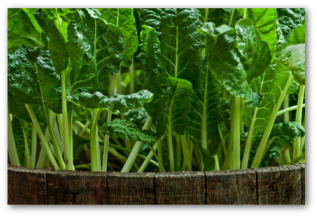Growing Swiss Chard in Your Garden

Get the best tips for growing Swiss chard in a backyard or container vegetable garden!
Learn how to plant and care for Swiss chard when home gardening.
Design Your Own Vegetable Garden Layout Using our Free "Vegetable Garden Planner" Software!
Swiss chard was popular long before the time of the Romans.
This beet variety is grown for the edible leaves and stalks it produces rather than its roots.
The chard's claim to fame for gardeners is its ability to take the hot summer temperatures that cause other crops such as lettuce or spinach bolt quickly to seed.
Download Free Garden Planning Worksheets, Garden Diary, Zone Chart, Or Planting Guide
Growing Swiss Chard
- Begin Swiss chard at the same time as you plant your beets in mid-spring.
- The vegetable is a very adaptable crop, tolerant of both frost and hot weather.
- In fact, it is a good hot-weather substitute for spinach.
Planting Swiss Chard in a Backyard or Container Garden
- Direct sow the chard seed 3 inches apart in rows 18 to 24 inches apart, 1 to 2 weeks before the average last frost date.
- If planting in a container, sprinkle the seeds in the container and cover with 1/2 inch of soil.
- After the chard sprouts and begins to grow, thin plants to 3 inches apart.
- You can wait to thin when the plants are large enough to use as "baby greens" in a salad. That way they won't go to waste!

When to Plant Swiss Chard
- Swiss chard will germinate in soil temperature ranging from 40 to 85 degrees.
- With this wide range of temperatures, the vegetable can be planted from very early spring to midsummer.
How to Grow Swiss Chard
- The plants prefer full sun to partial shade, well-drained soil rich in organic matter, with a pH of 6.0 to 6.8.
- In mild climates, seeds can be directly sown in the vegetable garden in early fall for a winter or early spring crop.
- Like beet seed, Swiss chard seed is actually a cluster of up to eight seeds from which a clump of seedlings develops.
- To get the best final spacing, the plants in rows should
be thinned to spacing of 4 to 8 inches when they reach about 6 inches
high.
- In beds, space plants 9 inches apart in all directions.
- The thinning can be used for serving your family nutritious greens or used in salads.
Favorite Varieties of Swiss Chard

You have plenty of varieties to choose from when planting Swiss chard.
Here are just a few of your choices:
‘Rhubarb Chard' is ready to be harvested in 60 days.
The variety had dark green leaves and red stalks.
This type is a favorite vegetable for the flowerbed or border.
Harvest ‘Lucullus' also in 60 days.
This kind has light green leaves, broad white stalks, and a mild spinach-like flavor.
'Fordhook Giant' is ready for harvesting in 60 days as well.
As the name suggests, it produces very wide, thick, white stalks and dense, crinkly, dark green leaves.
A Tip for Growing Swiss Chard
How to Extend the Harvest
By harvesting leaves regularly and keeping the soil moist, the crop continues producing all summer into the fall.
Harvesting Swiss Chard

One of the benefits of growing Swiss chard is that you can harvest the vegetable over many months from a single planting.
The large, crinkly leaves and colorful, fleshy stalks can be harvested from the plant as it grows.
Even if you snip the entire plant an inch or so above the crown, new foliage will continue to grow.
Another benefit is that because you are able to cut leaves from the plants continuously, it makes successive sowing of the crop unnecessary.
Swiss Chard Uses in the Kitchen
In case you have never experienced growing Swiss chard, we have included some serving ideas for the delicious vegetable.
- Cut the thick stalks into 2 or 3 inch lengths and simmer in boiling salted water until tender.
- Serve hot with butter and a touch of wine vinegar.
- Chill and toss using a vinaigrette dressing.
Another Swiss Chard Recipe Idea:
- Coarsely chop the leaves and cook quickly in just the water that clings to the leaves.
- Dress with butter and salt.
- Serve hot cooked greens in a hot bacon and white-vinegar dressing.
- Sprinkle with shredded hard-boiled egg.
- Alternatively, the chopped Swiss chard leaves can be added to Italian minestrone.
Back To Top
Growing Swiss Chard to Vegetable Gardening

